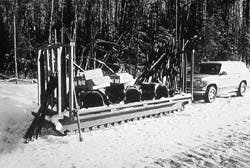SCREW ANCHORS ECONOMICALLY CONTROL PIPELINE BUOYANCY IN MUSKEG
Randy Robertson, Ron CurleNOVA Gas Transmission Ltd., Calgary
To control buoyancy of large-diameter pipelines that cross such wet areas as muskeg swamps in Alberta Province, Canada, NOVA Gas Transmission Ltd., Calgary, for more than 6 years investigated alternatives to traditional concrete weights.
The company's research indicated that helical screw anchors offer cost-effective buoyancy control for natural-gas pipelines 20-in. OD and larger.
NOVA's system encompasses 19,000 km (11,800 miles) of pipelines ranging from 2 to 48 in. OD. In the last 3 years, the company has constructed more than 300 km (180 miles) of 42 and 48-in. pipelines.
This expansion has occurred mainly along the eastern slopes of the Rocky Mountains and in Alberta's northern forests: areas characterized by intermittent muskeg swamps. Muskegs are organic soils with high water tables, low shear strengths, and low densities (specific gravity of 1.04).
Construction costs for large-diameter pipelines in muskeg are at least 20% higher than those incurred in dry areas. Buoyancy control using concrete weights is a significant portion of these extra costs.
In Alberta, pipeline construction in muskeg areas normally proceeds during the winter. The frozen muskeg provides access and support for pipe, concrete weights, and heavy equipment.
Trucks which are used to haul the concrete weights produce some of the highest earth loads encountered during construction. These loads may cause the frozen muskeg to fail, resulting in construction delays and increased costs.
NOVA's buoyancy-control research initially focused on refinements of the swamp-weight spacing requirements, by investigating backfill properties to reduce conservatism in the design.
Advancements in pipeline-buoyancy control with geotextile swamp weights1 and plate weights2 on small diameter pipelines have now been complemented by use of helical screw anchors on large diameter pipelines.
While the use of screw anchors is not new to the pipeline industry, they have seen limited application in high production situations on large diameter pipelines in Canada.
NOVA's experience demonstrated practical and cost benefits of screw anchors to resist uplift forces. And among other benefits, substitution of screw anchors for concrete weights significantly reduced the number of heavy trucks that must be moved across the muskeg.
BUOYANCY CONTROL; ANCHORS
Pipelines will "float" to the surface when the weight of the pipe and contents, plus the resistance provided by the backfill, is less than the buoyant force on the pipeline.
The following equations describe the forces acting on the pipeline shown in Fig. 1:(87974 bytes) Bp - Mp (g) = (2) Fs, for Fig. 1a(87974 bytes); Bp - Mp (g) = Mc (g) - Bc, for Fig. 1b.(87974 bytes)
The net buoyant force on the pipeline (BP - MP [g]) must be counteracted by either the force developed by a screw anchor assembly (2FS) or the force exerted by a submerged concrete weight (Mc [g] - BC).
A screw anchor is a circular helical plate welded to the end of a steel shaft (Fig. 2)(71388 bytes).
Rotation of the shaft advances the helix into the soil with an action similar to that of a wood screw.
The first anchoring system was developed in 1912 for use on electrical transmission tower guy lines.3 Screw anchors now have applications in many industries, including pipelines.
For an application where the screw anchor shaft is in tension (for example, pipeline buoyancy), the shaft is typically made from 38 mm (1.5 in.) square solid steel and is 1.8 m (6 ft) to 3.0 m (10 ft) long.
The designer may vary the length of shaft, number of helices and their diameters, and number of anchors to develop the load resistance required.
In most cases it is necessary to install the helix into a soil layer at a depth exceeding the length of the screw-anchor shaft. To reach this depth, screw anchors utilize one or more extensions that will increase the length of the screw-anchor shaft.
Shaft extensions are typically 1.8 m (6 ft) to 3.0 m (10 ft) long.
Screw anchors utilize the soil strength to resist loads. The greater the strength of the soil into which the screw anchor is installed, the greater the magnitude of the load that can be resisted by the screw anchor.
Load resistance is derived from a combination of the bearing capacity of the soil in contact with the helix and the shear strength of the soil acting on a cylindrical surface above the perimeter of the helical plate.
PIPELINE ADAPTATION
Screw anchors were initially used for pipeline buoyancy control in the 1950s. Because the load-resistance mechanism of the anchor was not well understood and quality control was not focused on this aspect of pipeline construction, NOVA abandoned the use.
The screw-anchor assembly consists of two screw-anchor shafts and a pipe saddle (Fig. 3)(163373 bytes). If both screw anchors are to be installed at the same time, counter rotating pitches are used. This technique prevents the development of high torque on the installation equipment or rotation of the saddle during installation.
Since the holding capacity of the screw anchor depends on the properties of the soil encountered beneath the muskeg, accurate soil data are required for design.
Soil investigation and data collection will reduce construction costs by applying accurate soil properties rather than conservative estimates in the anchor design. There is, however, an economic limit to the effort that should be applied to data collection.
A relative measure of soil shear strength can be determined by inserting a special steel probe into the ground. The probe is a continuous-flight auger, 38 mm (1.5 in.) in diameter, 400 mm (16 in.) long, and mounted on a slender steel shaft.
The probe is rotated into the ground to the desired depth, a measurement taken of the torque required to advance the probe, and the data analyzed.
With the use of the manufacturer's design manual,3 holding capacities of standard screw-anchor sizes may be determined for a particular soil strength. The maximum screw-anchor assembly spacing is determined by the working load of each screw anchor shaft.
For soil commonly encountered in Alberta, it has been found that the maximum working load that may be applied to each properly installed screw anchor is 89 kN (20 kips).
Screw anchors are viable only in locations where they can be readily installed. If bedrock, cobble, or coarse gravel is encountered below the muskeg, a helix cannot be advanced into the substrate. In these situations, screw anchors are not feasible.
Similarly, if the muskeg is more than 13 m (42 ft) deep, several shaft extensions will be required, and the logistics of installation become prohibitive.
PIPE STRESS, CORROSION
The designer of a screw anchor buoyancy-control system must also address pipe stress limitations.
A pipeline in muskeg acts as a uniformly loaded, continuous-span beam (Fig. 4)(60602 bytes). Maximum bending stress limits must not be exceeded. As the spacing between the screw-anchor assemblies is increased, pipe bending stress is increased.
NOVA has found that for pipelines smaller than 36 in., screw-anchor assembly spacing is governed by bending stresses in the pipe. For pipelines larger than 36 in., the maximum working load on each screw anchor governs the spacing design.
Stresses developed on the pipe at the edge of the saddle must also be considered in a screw-anchor assembly design.
Corrosion of the steel screw-anchor assembly must be addressed by the designer. The screw-anchor shaft has an inherent corrosion tolerance as the cross section required to withstand the installation torque exceeds that required to withstand the tensile load.
The helix plate and anchor shaft are installed in undisturbed soil which inhibits corrosion of these elements; therefore the corrosion design focuses on the pipe saddle.
Specifications for thickness and type of protective coating on the steel saddle are based on soil conditions, chemical properties of the muskeg swamp, and required design life. The initial design of the screw-anchor saddle was based on conservative corrosion estimates.
The saddle was formed from 16 mm (5/8 in.) thick steel plate and was coated with coal-tar epoxy. A typical 42-in. pipe saddle weighed 95 kg (209 lb). Subsequent design reviews have reduced the thickness to 12 mm (1/2 in.) and the weight to 80 kg (175 lb).
NOVA is currently evaluating alternate pipe-saddle designs using non-metallic materials. Corrosion potential would be reduced. A plastic resin pipe saddle would weigh less than 40 kg (88 lb), a definite advantage with respect to ease of installation.
Design of the helices has been a major focus of NOVA's screw-anchor research and development program.
The first work with screw-anchor buoyancy control used a multihelix design that incorporated two 300-mm (12 in.) diameter helices on a single shaft.
During installation, the upper helix could come in contact with the pipe at the 3 o'clock position and damage the coating. A single helix was preferable, but helix diameters larger than 300 mm (12 in.) had not been previously manufactured.
NOVA successfully embarked on a joint effort with the screw-anchor manufacturer to develop a 400 mm (16-in.) diameter helix.4 Buoyancy control design based on screw anchors with this diameter of helix have now been standardized.
CONSTRUCTION, INSTALLATION
Proper screw-anchor installation is critical for pipeline stability.
An improperly installed screw anchor may not resist the buoyant force and could fail, thereby allowing the pipeline to deflect upwards.
A failure of a single screw-anchor assembly could be detrimental to the entire buoyancy-control system. If one assembly fails, the resultant load transfers to each of the two adjacent assemblies, and they could also fail.
To guard against this failure, NOVA has employed an inspection program and a 2.5 factor of safety on each screw anchor.
A trained field inspector monitors each screw-anchor assembly installation and records screw-anchor installation torque, load test results, final length of screw-anchor shaft, total number of assemblies installed, and actual spacing of assemblies.
The inspector also monitors changes in physical condition of the screw-anchor assembly, and checks the pipe for damage caused by screw-anchor installation.
Each pair of screw anchors, on every fifth anchor assembly, is pull tested to 115% of the working load. The test load is applied with standard pipeline construction equipment and measured with a dynamometer.
A complete test on one assembly takes approximately 5 min.
ECONOMICS
Screw anchors have been used successfully for pipeline buoyancy control in various terrains. An economic analysis of alternate buoyancy-control measures is the most common justification for using screw anchors.
Concrete swamp weights designed for large-diameter pipelines are very costly. The cost of concrete swamp-weight supply, transportation, and installation is more than 20% of total construction costs in wet areas.
For pipeline construction in remote areas, the cost of transportation of the swamp weights to the right-of-way can further increase costs.
Cost savings of up to 50% for buoyancy-control measures have been realized through the use of screw anchors as an alternative to concrete swamp weights.
There are three primary reasons for screw anchors being less expensive:
- Increased spacing of buoyancy-control devices. Concrete swamp weights for 42-in. OD pipe have a mass of 5,600 kg (12,320 lb). The concrete is subject to a buoyant force when installed into a swamp.
Therefore, the 5,600-kg concrete swamp weight has an effective mass of 3,050 kg (6,710 lb) to resist the buoyancy of the pipeline. Swamp weights for 42-in. pipe are typically spaced at 4.2 m (14 ft) centers along the pipeline.
The buoyant forces on a screw-anchor assembly are negligible. For NOVA's typical applications, a screw anchor is assumed to develop an ultimate hold-down force of 222 kN (50 kips), or 444 kN/assembly.
Assuming a factor of safety of 2.5, the screw-anchor assembly would provide a working load of 178 kN. This force is more than five times the working load provided by a single concrete swamp weight.
Screw-anchor assemblies can be placed at 20.0 m (65 ft) centers on a 42-in. pipeline.
The pipeline right-of-way is typically in a remote area where the nearest concrete plant could be more than 300 km away.
A truck with a maximum payload of 18,000 kg can carry three 42-in. concrete weights. Three weights provide enough buoyancy control for 12.6 m (41 ft) of pipeline.
The same truck, limited only by space requirements" can carry 50 screw-anchor assemblies. This load of screw-anchor assemblies provides enough buoyancy control for 1,000 m of pipeline.
A 1,000-m section of pipeline in a wet area requires either one truck load of screw-anchor assemblies, or 80 truck loads of concrete swamp weights.
- Reduced storage costs. Both concrete swamp weights and screw anchors require relatively long lead times for manufacturing, when compared to the duration of pipeline construction.
Once concrete swamp weights are trucked to a site, it would cost more for transportation back to a central storage area than the original cost to purchase them.
The standardized screw-anchor design reduces the number of different parts in inventory. Identical screw anchors are used in assemblies for all large diameter pipelines.
Screw anchors are easily stockpiled and surplus material can be economically transported back to a central storage area (Fig. 6).OTHER BENEFITS
In addition to the measurable economic benefits of screw anchors, they also contribute to reducing the overall construction costs in the following ways:
- Reduced congestion on the pipeline right-of-way. Concrete swamp weights are very large with outside dimensions of a typical 42-in. concrete swamp weight being 1.8 m x 1.7 m x 1.4 m. Concrete weights typically require an additional 3 m (10 ft) width of temporary work space for storage and handling. Many trucks are required to travel along the right-of-way and string out the concrete swamp weights.
Screw-anchor assemblies do not require additional work space above that required for pipeline construction in dry terrain
- Reduced ditch dimensions. Alberta pipeline regulations require that the top of the pipeline be buried to a depth of at least 0.8 m (31 in.). When concrete weights are used for pipeline-buoyancy control, the tops of the concrete weights must be at a depth of at least 0.8 m.
Because the concrete weight is 0.3 m (12 in.) thick at the top of the pipe, the pipe ditch must be deeper to account for this dimension.
A screw-anchor assembly requires no extra depth of ditch because the thickness of the saddle is negligible.
- Concrete swamp weights of 42 in. also require that the ditch be an extra 0.3 m wide for the entire length of the swamp. Screw-anchor assemblies only require extra width ditch every 20 m along the pipeline.
- Safety. Concrete swamp weights are usually strung out along the edge of the pipeline right-of-way before the ditch has been excavated, resulting in increased congestion.
The use of screw anchors as an alternate to concrete swamp weights reduces truck traffic, reduces congestion, and decreases the number of heavy lift operations.
The result is a safer work environment for the construction crew when screw-anchors are used.
The economic benefit of screw-anchors over concrete swamp weights increases with an increase in pipe diameter.
NOVA has gathered data on the costs of screw-anchor installations on 30, 36, 42, and 48-in. pipelines. Cost estimates for screw-anchor installations on other pipe sizes have also been developed.
Fig. 7 (25084 bytes) compares the cost of screw anchors with concrete swamp weights.
It should be noted that more manpower is required for each individual screw-anchor assembly than an individual concrete swamp weight installation.
When the labor requirements of all the support activities that accompany a concrete swamp weight installation are considered, however, along with number of concrete weights required, the manpower necessary for screw-anchor assembly installations becomes acceptable.
As a result of the success of NOVA's screw-anchor development program, screw anchors are now standard buoyancy control on all large-diameter pipelines. Cost savings of approximately $1.5 million (Canadian), 30% of total buoyancy control costs, were realized on the projects utilizing screw anchors for buoyancy control in 1993/94.
ACKNOWLEDGMENTS
The authors acknowledge the cooperation and support of NOVA Gas Transmission Ltd.'s engineering department and the continued support of the management of NOVA Gas Transmission Ltd. Special thanks are due A.B. Chance Co. and Energy Structures Inc. And the authors are grateful to Samuel P. Clemence, Syracuse University, for his continued assistance in this program.
REFERENCES
1. Marshall, R.G. and Rizkalla, M., "Geotextile Swamp Weights: A New Method of Pipeline Buoyancy Control," ASME, Pipeline Engineering, 1991, Vol. 34, pp. 27-31.
2. Boivin, R.P., "Plate Weight Research Project Phase 3," Calgary: Design Engineering Department, NOVA Corp. of Alberta, internal report. 1992.
3. Encyclopedia of Anchoring, A.B. Chance Co. (1990).
4. Clemence, S.P., "Report on Helical Anchor Evaluation Field Testing Program for NOVA Corporation of Alberta," Survey and Civil Engineering Department, NOVA Corp. of Alberta, Calgary; internal report, 1994.
OTHER SOURCES
Mitsch, M.P., and Clemence, S.P., "The Uplift Capacity of Helix Anchors in Sand," ASCE (1985), Uplift Behaviour of Anchor Foundations in Soil, pp. 26-47.
Mooney, J.S., Adamczak, S., Jr., and Clemence, S.P., "The Uplift Capacity of Helical Anchors in Clay and Silt," ASCE (1985), Uplift Behaviour of Anchor Foundations in Soil, pp. 48-72.
Robertson, R., "Assessment of Screw Anchor Buoyancy Control for Large Diameter Pipelines," Calgary: Survey and Civil Engineering Department, NOVA Corp. of Alberta, internal report, 1993.



